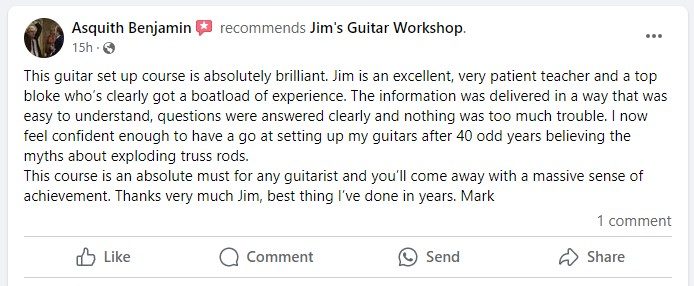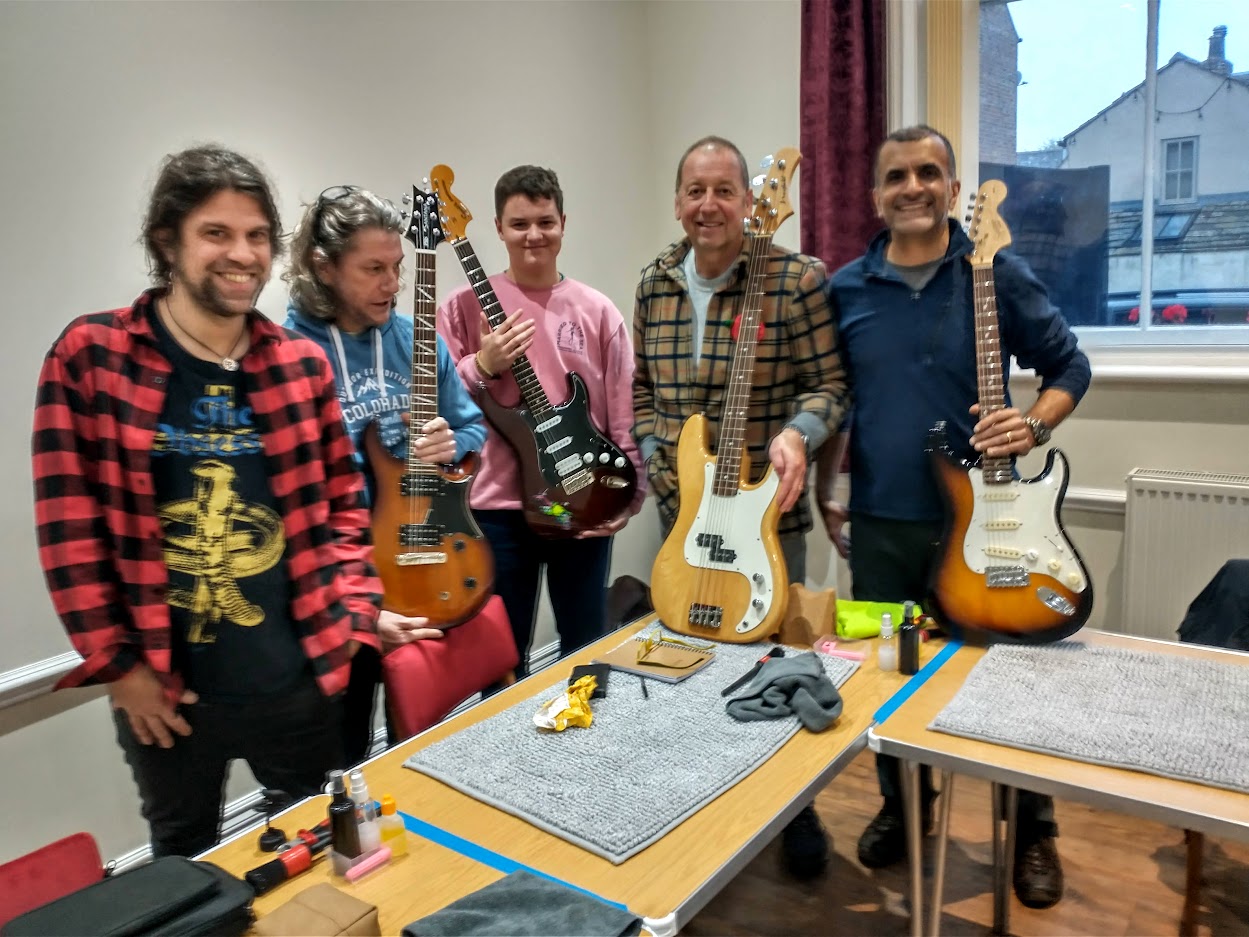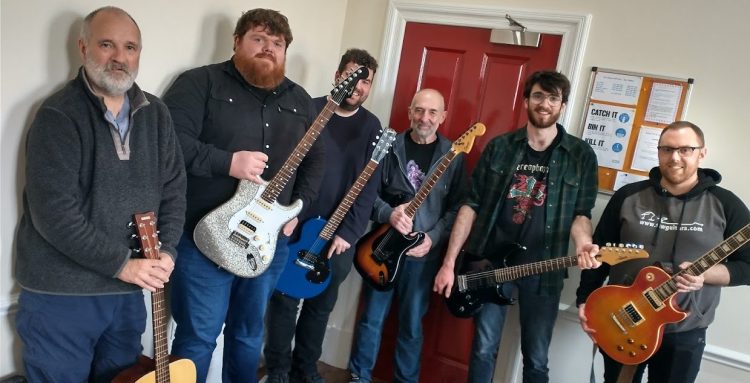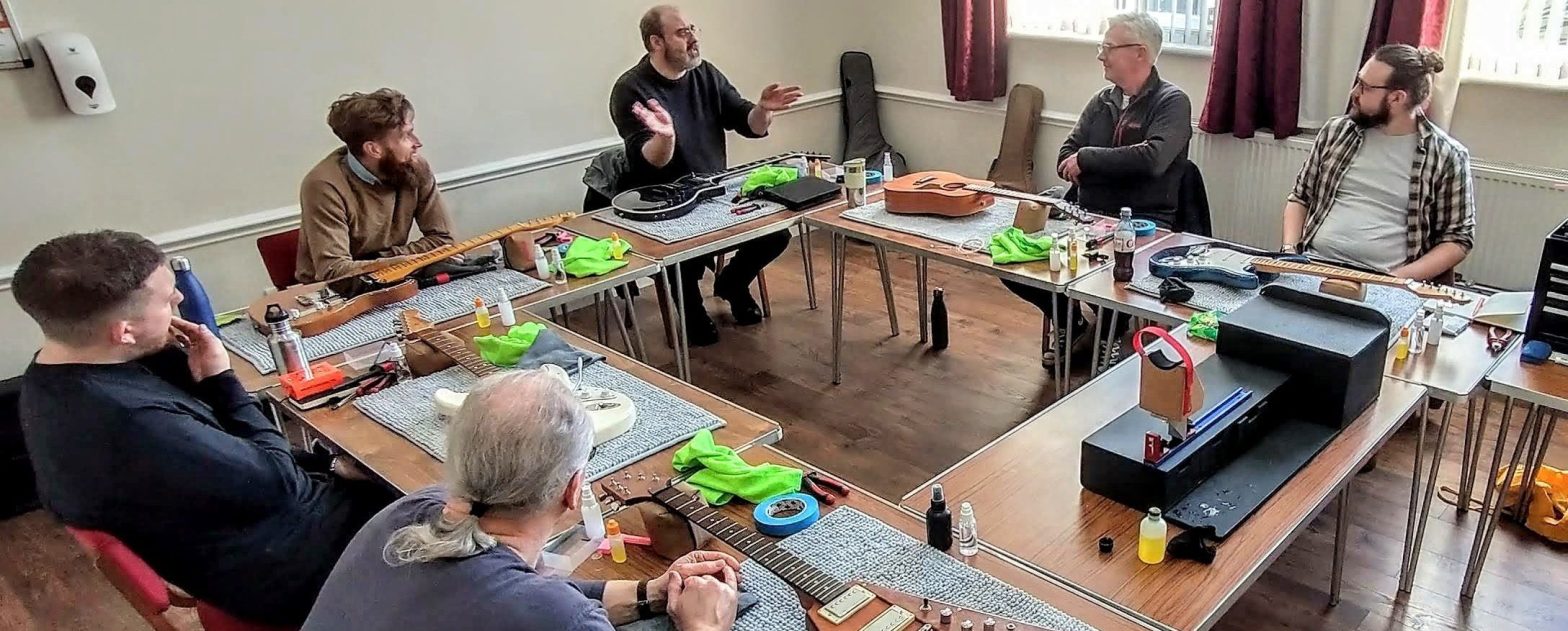Hello! My name is Jim Croisdale and I’m a full time professional guitar tech based in Leeds, West Yorkshire (see my business website HERE and my Facebook page HERE).
I work on approximately 600 guitars a year, and have been setting up and repairing guitars for nearly 30 years. In March 2022 I did my first guitar tech class, and have been holding them once a month in Leeds since then. So far, I’ve done over 18 classes and taught over 100 students.
For 2024, I’m planning on holding guitar tech courses in other cities in England, to reach more people for whom travelling to Leeds isn’t an option.

When Are The Courses Held?
Courses are generally held on a Sunday and run from 10am til around 5pm. Sometimes we finish a little earlier, sometimes a little later, depending on what the six guitars need.
Where Are The Courses Held?
Click HERE for Leeds, HERE for Manchester, HERE for Birmingham or HERE for London
Who Is The Course For?
The course provides valuable information for any guitarist who wants to learn how to set up their own instrument and maintain it so that it always plays at its best! The course is also useful for people that work in music shops, people that work in school or college/university music departments, theatrical production staff or techs who work with live bands on the road. Click here to read more about who can benefit from a guitar tech course.
What Types of Guitar Can I Bring?
The course is fine for either electric, acoustic or bass guitars – most (if not all!) of the steps covered will apply to all of these kinds of instrument – no problem at all. Fixed or floating bridges are fine. Twelve strings are fine. Eight string basses are FINE! The only real point is that the instrument has to be functional – we’re learning to set up a guitar, not reassemble one from a carrier bag full of bits, or repair a guitar with the electronics hanging out, or a guitar with a broken neck.
What Do I Need To Bring With Me?
When you book onto one of my courses you need to bring a few things:
- A guitar (see above)
- New strings for the guitar (no, we can’t keep the old ones on)
- Pen and paper if you want to make notes
- Your favourite guitar tuner if you’ve got one
- Any tools you’d like to try (this isn’t essential though!)
- A packed lunch and drinks
- A terrible hangover is not recommended…. 🙂
What’s Supplied On The Course?
Every student is supplied with a few things to use on the course day:
- A table and chair
- A soft guitar mat and a neck rest
- Cleaning cloths
- Duster brush
- String winder
- Guitar cleaner
- Fretboard cleaner and conditioner
- String cutters

What’s Covered On The Course?
Each course date follows these basic steps:
- Initial Assessment of the Instrument
Before we remove the strings we can give the guitar a play-test and make sure that everything is working ok, or work out where any problems may be.
- Removal of Old Strings
Now we go through the process of removing the old strings safely, without scratching or damaging the instrument or losing any parts that fall off 🙂
- Cleaning of the Fretboard & Frets
Now we use solvents and/or scrapers to remove any dirt from the fretboard, before conditioning the wood and then polishing the frets back to a shine.
- Cleaning of the Body, Neck and Parts
Now’s also the time to clean the body, neck and headstock, and all the parts. A clean and shiny guitar looks, feels and smells better!
- Restringing
Now I’ll show you the BEST way to restring your guitar. A no BS approach to guitar stringing that’s fast, easy, and helps your guitar to stay in tune. How do I know? ‘Cos I’ve strung THOUSANDS of guitars this way!
- Truss Rod Adjustment
Now we adjust the truss rod using a range of tools to get the neck to the correct level of straightness. You won’t be scared of the truss rod once you know how they work.
- Nut slot adjustment (depth, width and angle)
Now we look at the nut, and using the correct tools we will go through the setting of the nut slots – making sure they are the correct width and depth, and that they’re at the right angle too!
- Action Adjustment
Now we adjust the action at the bridge. Using the correct tools, you’ll learn how to adjust action on a variety of bridge types.
- Intonation
Now we adjust the intonation at the bridge to make sure that the guitar plays in tune all over the fretboard, as well as it possibly can.
- Final Check & Test
Now we have a final play on the guitar just to make sure everything’s ok! Hopefully, we’ve now got a guitar that plays perfectly and a lot of new skills to boot!
However, all the steps above aside, I think that the most important part of the day is the discussion that we have between us all as we go through these steps. You can ask as many questions as you like, and I’ll always do my very best to help. There’s six people on the courses too, so you’ll get to see five other different guitars being worked on – valuable extra knowledge! It’s always a great day of guitar talk, and hey – I usually learn a few things myself too!
Click HERE for Leeds, HERE for Manchester, HERE for Birmingham or HERE for London

